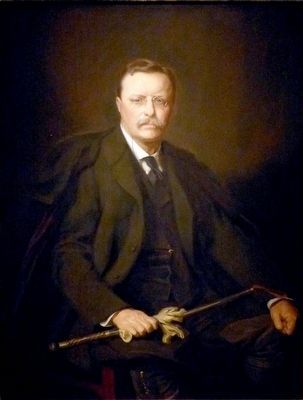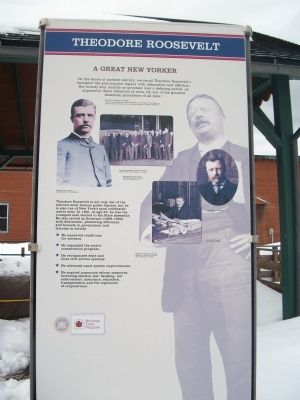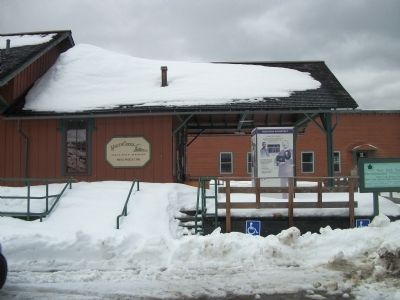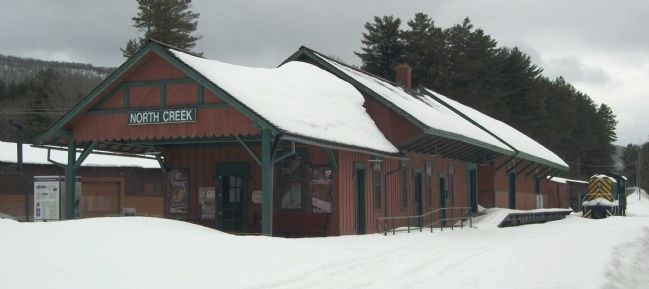North Creek in Warren County, New York — The American Northeast (Mid-Atlantic)
Theodore Roosevelt
A Great New Yorker
Theodore Roosevelt is not only one of the nation's most famous public figures, but he is also one of New York's most celebrated native sons. In 1881, at age 23, he was the youngest man elected to the State Assembly. He also served as Governor (1898-1900) with distinction, promoting efficiency and honesty in government and fairness in society:
• He improved conditions for workers.
• He expanded the state's conservation program.
• He reorganized state and local civil service systems.
• He advanced canal system improvements.
• He enacted numerous reform measures, including election law, banking law, law enforcement, insurance, education, transportation and the regulation of corporations.
Topics. This historical marker is listed in this topic list: Government & Politics. A significant historical year for this entry is 1998.
Location. 43° 42.177′ N, 73° 59.357′ W. Marker is in North Creek, New York, in Warren County. Marker is on Railroad Place, on the right when traveling north. Marker is near the top of the steps to the North Creek Railroad station. Touch for map. Marker is in this post office area: North Creek NY 12853, United States of America. Touch for directions.
Other nearby markers. At least 8 other markers are within walking distance of this marker. A different marker also named Theodore Roosevelt (here, next to this marker); North Creek Railway Station (a few steps from this marker); Welcome to North Creek (a few steps from this marker); a different marker also named Theodore Roosevelt (within shouting distance of this marker); a different marker also named Theodore Roosevelt (within shouting distance of this marker); North Creek Depot (within shouting distance of this marker); Adirondack Railway Company (within shouting distance of this marker); Barton Mines (within shouting distance of this marker). Touch for a list and map of all markers in North Creek.
Also see . . . 26th President of the United States, 1901-1909. (Submitted on April 3, 2011, by Howard C. Ohlhous of Duanesburg, New York.)

Photographed By Allen C. Browne, August 9, 2015
4. Theodore Roosevelt
This 1967 portrait of Theodore Roosevelt by Adrian Lamb after Philip de Lászlo's 1908 original hangs in the National Portrait Gallery in Washington DC.
“No one ever craved the presidency more than Theodore Roosevelt or used its powers more joyously. In early 1901, however, his rise toward that office was suddenly checked. Having gained national prominence as a civil service reformer, Spanish-American War hero, and reform-minded governor of New York, he was now relegated to being William McKinley's vice president. But McKinley's assassination several months later changed everything, and Roosevelt was soon rushing headlong into one of American history's most productive presidencies. By the time he left office in 1909, his accomplishments ranged from implementing landmark efforts to conserve the nation's disappearing natural heritage, to instituting some of the first significant curbs on the excesses of big business, to building the Panama Canal.
When Hungarian-born English artist Philip de Lászlo painted the original version of this portrait, he encouraged Roosevelt to have visitors chat with him during the sittings, apparently thinking that it made for a more animated likeness.” — National Portrait Gallery
“No one ever craved the presidency more than Theodore Roosevelt or used its powers more joyously. In early 1901, however, his rise toward that office was suddenly checked. Having gained national prominence as a civil service reformer, Spanish-American War hero, and reform-minded governor of New York, he was now relegated to being William McKinley's vice president. But McKinley's assassination several months later changed everything, and Roosevelt was soon rushing headlong into one of American history's most productive presidencies. By the time he left office in 1909, his accomplishments ranged from implementing landmark efforts to conserve the nation's disappearing natural heritage, to instituting some of the first significant curbs on the excesses of big business, to building the Panama Canal.
When Hungarian-born English artist Philip de Lászlo painted the original version of this portrait, he encouraged Roosevelt to have visitors chat with him during the sittings, apparently thinking that it made for a more animated likeness.” — National Portrait Gallery
Credits. This page was last revised on November 28, 2019. It was originally submitted on April 2, 2011, by Howard C. Ohlhous of Duanesburg, New York. This page has been viewed 458 times since then and 25 times this year. Photos: 1, 2, 3. submitted on April 2, 2011, by Howard C. Ohlhous of Duanesburg, New York. 4. submitted on October 24, 2015, by Allen C. Browne of Silver Spring, Maryland. • Bill Pfingsten was the editor who published this page.


